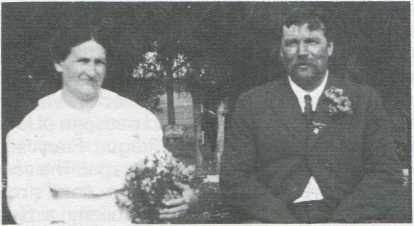The census schedule stated that by 1870, their farm had increased in value to $5,800.00. John had one hundred acres under cultivation, plus one hundred and eighty unimproved acres. He still fed only four hogs, but now had six milk cows and four “other cattle” in the pasture. During the previous year, he had marketed 750 pounds of butter, which was made in an old-fashioned hand-operated churn. This was a tall ceramic jar in which a wooden-bladed plunger was worked up and down. His livestock had tripled as did the yield of his fields. Four draft horses replaced the oxen, which had been sold or converted into beef. One of the oxen he had loaned to a neighbor, John Ruzicka. Two weeks later, in Othmar Kapler’s justice of the peace court, Klimesh sued Ruzicka for damages after “said ox was killed by the defendant.” The outcome of the suit, in which John asked for $95.00, and whether the killing was intentional or not, is not known. At the hearing held a week later, Ruzicka asked for a change in venue and the trial was moved to an unknown court, after costs of $4.45 had been paid. The charges included a twenty-five cent fee paid to each of five witnesses called by the defendant.
How actively John pursued the masonry trade after he began farming has not been determined. He had built his house and barn, and according to family tradition, had helped with the construction of the church. County records indicate that he had hired out for at least one project: the laying of the abutments for a county bridge. In 1890 after selling most of the farm to his sorrfdsseph, John moved his family to Manly, IA, where his oldest Son, John was farming. Within a year they returned to Winneshiek Co and John opened an implement-shop on a lot he had purchased in Spillville. Initially, the family lived in a small cottage across the street, but John soon replaced that with a large, two-story house which was decorated with embossed sheet iron, inside and out. He ran the business until 1899. Late that year, he sold the shop to his son Robert, who razed it to make room for a home. A few months after moving in, Robert sold the house to his father and moved to Missouri. Later, John transferred title of the property to his daughters, Eleanor and Josephine. Evidence of John and Anna's deeply religious nature are the statues of Our Lady of Lourdes which they donated to the churches at Little Turkey, Protivin and Spillville.
Anna died 16 Mar 1905. John died 22 Aug 1908. Both are buried in St. Wenceslaus Cemetery in Spillville. John's demise was reported in the Decorah Republican: “Last Sunday morning, early, the church bell announcing the death of John Klimesh, Sr. was heard. During the last few years Mr. Klimesh was growing more and more feeble, until 9 o’clock Saturday evening, when his death came. Father Broz performed the obsequies, and was assisted by Father Lakomy of Protivin, who also delivered an eloquent sermon. Mr. Klimesh was 82 years old and was one of the pioneer settlers. He came here from Europe about 50 years ago and settled in Winneshiek Co. He also helped build the church here and made several liberal donations to this, as well as several other churches.
He leaves four sons and six daughters. His four sons and two grandsons were the pall bearers." John and Anna were proceeded in death by three children.
Klimesh, Joseph and Barbara (Kortan)
(Dolores E. Ira)

Joseph and Barbara Kortan Klimesh,
25th Wedding Anniversary.
Joseph F. Klimesh was born 5 May 1868 to John and Anna Mikota Klimesh, on the family farm west of Spillville in a two-story house built of native stone which has withstood the elements of time and stands today. This was in Section 16 of Sumner Twp, Winneshiek Co, IA. His father was born 14 Apr 1829 in Zverkovice, Bohemia, house #21, his mother 3 Nov 1838 at Purkarec, Bohemia, in house #42.
Joseph’s favorite work on the farm was tending to the hogs. On 3 Jun 1890, he married Barbara Kortan in St. John of Nepomucene Church at Ft. Atkinson, IA. Barbara was born 28 Sep 1871 in Ft. Atkinson, the daughter of Joseph and Anna Rezac Kortan. Joseph brought his bride to live in the house in which he was born, having bought the farm from his father. Joseph owned a threshing machine rig and traveled as far west as Saudi, IA to thresh grain. Sometimes he would be gone for several days, not returning until all the jobs were finished. The machine was powered by a large steam engine which he also used to run a portable sawmill which he acquired in 1902. After harvest was over, Joseph would travel to various localities to saw logs for the farmers. They were alerted that he was ready to start sawing when they saw a large sign by his driveway which read, “Get your logs ready.” Since most bridges were not strong enough to safely support the heavy steam engine, they had to be by-passed. At Spillville, he crossed the river east of the town hall and set up the sawmill there. The operation was an annual attraction to all the village youngsters, as well as several who weren’t so young. As was true on most farms, Joseph and Barbara had a cyclone cellar which served a dual purpose. Besides providing a safe haven from cyclones, (more accurately, tornadoes), they were used to store food; potatoes, apples, lard, fried-down pork, and whatever else was necessary.
Many relatives came to visit them from Omaha, NE; Chicago, IL; and St. Paul, MN. They always enjoyed Grandma’s home-made sweet buns, kolaches, bread and other goodies. Grandma was a good seamstress and
K-30
Complete OCR transcription.
See the associated scan to compare with the published information.

